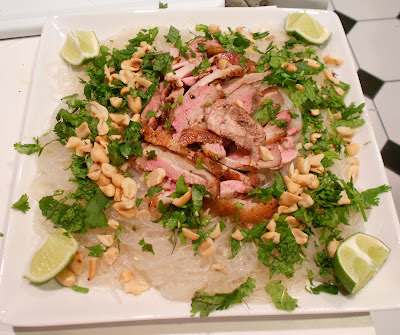 |
| Southern Vietnamese Fish Cakes |
For a cookbook to captivate me, it must add something novel
to my kitchen repertoire. And no, I’m
not talking about “50 Ways with Mac N Cheese”, or “Halfway Homemade with
Packaged Foods”. A good cookbook will
teach me. It might teach me technique,
as in the case of Jennifer McLagan’s book “Bones” which continues to provide
everything I might want to know about cooking meat on the bone. Or, more often these days, the book goes deep
into a particular cuisine of which I have only some familiarity but a lot of
curiosity.
“Secrets of the Red Lantern” is a bit of a hybrid book. Two parts family history, one part recipes,
it is Pauline Nguyen’s story of her family’s flight from Vietnam and settlement
in Australia told in words, pictures, and food.
 |
| Tom Rim- Shrimp in Tomato Sauce |
This is not the sort of book you take down all in one
sitting. But it is beautiful enough to
take a place on the coffee table allowing me to dip in a dip out to read tales
of Pauline and her brother Luke’s childhood, drool over the beautiful pictures
of some of the favorite family dishes, and dream up which recipe I wish to try
out next.
Favorites so far have included Luke’s recreation of one of
his mom’s signature dishes at his parents’ restaurant opened when they
resettled in Australia. Tôm
Rim, shrimp sautéed with tomato, fish sauce, and black pepper, was assembled
with ingredients I can find these days at any American supermarket- tomato
paste, shrimp, fish sauce, cilantro. But
the wide range and nuance of flavors from sweet to spicy to tart to bitter,
were pure Vietnam.
These days Pauline along with Luke and Mark Jensen, her
partner in life and love, make up the team behind the popular Sydney restaurant
Red Lantern. In addition to sharing
family recipes these three also manage to break down some better-known
Vietnamese dishes into step-by-step instructions simple enough to replicate at
home. Fish cakes, one of my favorite Vietnamese
appetizers, appear shockingly easy in this book. Even though the recipe can be done entirely
in the food processor, I took the chef’s recommendation to work the fish sauce
into the paste of mackerel, garlic, and green onion by hand. The work was tough but satisfying. I could see and feel the texture change to
the non-sticky consistency described in the book that signals it is ready to
form into cakes and fry.
Pauline writes in reference to the name of their restaurant,
“To raise a red lantern outside your home is a symbol of honoring good
company.” I don’t know when I will have
the pleasure of visiting Sydney, but until I do “Secrets of the Red Lantern” is
poised to keep me excellent company in the kitchen for sometime to come.
Amy Powell is a food and travel writer based in New York City. She is a graduate of Cornell University's School of Hotel Administration and the French Culinary Institute. Follow her on Twitter @amymariepowell
Amy Powell is a food and travel writer based in New York City. She is a graduate of Cornell University's School of Hotel Administration and the French Culinary Institute. Follow her on Twitter @amymariepowell





